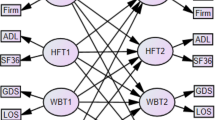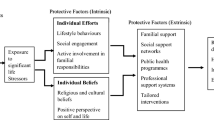Abstract
In this study, we examined the relationship between self-reported physical functioning and depressive symptoms by testing the mediation of identity processes in linking this relationship. Sixty-eight older adults (mean age = 74.4) participated in this cross-sectional study. Participants completed measures of physical functioning (Physical Symptoms Checklist), depressive symptoms (CESD-20) and identity processes (IES-G). The relationship between physical functioning and depressive symptoms was partially mediated by sensitivity of older adults to feedback from experiences, the process known as identity accommodation (Whitbourne et al. 2002). Not only are physical changes relevant to negative psychological outcomes in later adulthood, but it is the interpretation of these changes that seems to have particular relevance for aging individuals. Though preliminary based on cross-sectional data, the findings suggest that examining individual differences in sensitivity to aging stereotypes may help identify factors related to depressive symptoms in later adulthood. Future research is needed to disentangle these interrelated concepts.
Similar content being viewed by others
References
Atkinson, H. H., Rosano, C., Simonsick, E. M., Williamson, J. D., Davis, C., Ambrosius, W. T., et al. (2007). Cognitive function, gait speed decline, and comorbidities: the health, aging and body composition study. Journals of Gerontology Series A: Biological and Medical Sciences, 62, 844–850.
Baron, R. M., & Kenny, D. A. (1986). The moderator-mediator variable distinction in social psychological research: Conceptual, strategic, and statistical considerations. Journal of Personality and Social Psychology, 51, 1173–1182.
Cameron, L., Leventhal, E.A., & Leventhal, H. (1993). Symptoms representations and affect as determinants of care seeking in a community-swelling, adult sample population. Health Psychology, 12, 171–179.
Cameron, L., Leventhal, E.A., & Leventhal, H. (1995). Seeking medical care in response to symptoms and life stress. Psychosomatic Medicine, 57, 37–47.
Charney, D. S., Reynolds, C. F., 3rd, Lewis, L., Lebowitz, B. D., Sunderland, T., Alexopoulos, G. S., et al. (2003). Depression and bipolar support alliance consensus statement on the unmet needs in diagnosis and treatment of mood disorders in late life. Archives of General Psychiatry, 60, 664–672.
Christensen, H., Jorm, A. F., Mackinnon, A. J., Korten, A. E., Jacomb, P. A., Henderson, A. S., et al. (1999). Age differences in depression and anxiety symptoms: a structural equation modelling analysis of data from a general population sample. Psychological Medicine, 29, 325–339.
Cramer, P., & Jones, C. J. (2007). Defense mechanisms predict differential lifespan change in self-control and self-acceptance. Journal of Research in Personality, 41, 841–855.
Davey, A., Halverson, C. F., Jr., Zonderman, A. B., & Costa, P. T., Jr. (2004). Change in depressive symptoms in the Baltimore longitudinal study of aging. Journal of Gerontology: Psychological Sciences, 59, 270–277.
Everson-Rose, S. A., Skarupski, K. A., Bienias, J. L., Wilson, R. S., Evans, D. A., & Mendes de Leon, C. F. (2005). Do depressive sypmtoms predict declines in physical performance in elderly, biracial population? Psychosomatic Medicine, 2005, 609–615.
Gatz, M., & Hurwicz, M. L. (1990). Are old people more depressed? Cross-sectional data on center for epidemiological studies depression scale factors. Psychology and Aging, 5, 284–290.
Hertzog, C., Van Alstine, J., Usala, P. D., Hultsch, D. F., & Dixon, R. (1990). Measurement properties of the center for epidemiological studies depression scale (CES-D) in older populations. Psychological Assessment, 2, 64–72.
Hess, T.M., Birren, J.E., & Schaie, K.W. (2006). Attitudes toward aging and their effects on behavior. In Handbook of the psychology of aging (6th ed.). (pp. 379–406). Amsterdam Netherlands: Elsevier.
Jones, K.M., Whitbourne, S.K., Skultety, K.M., & Whitbourne, S.B. (2009). Identity processes and memory controllability in middle and later adulthood. Journal of Applied Gerontology.
Kraus, A. (1996). Psychotherapy based on identity problems of depressives. American Journal of Psychotherapy, 49, 197–202.
Laidlaw, K. (2001). An empirical review of cognitive therapy for late life depression: does research evidence suggest adaptations are necessary for cognitive therapy with older adults? Clinical Psychology & Psychotherapy, 8, 1–14.
Laidlaw, K., Davidson, K., Toner, H., Jackson, G., Clark, S., Law, J., et al. (2008). A randomised controlled trial of cognitive behaviour therapy vs treatment as usual in the treatment of mild to moderate late life depression. International Journal of Geriatric Psychiatry, 23, 843–850.
Landreville, P., Landry, J., Baillargeon, L., Guerette, A., & Matteau, E. (2001). Older adults' acceptance of psychological and pharmacological treatments for depression. Journals of Gerontology: Psychological Science, 56, P285–291.
Levy, B. R., & Leifheit-Limson, E. (2009). The stereotype-matching effect: greater influence on functioning when age stereotypes correspond to outcomes. Psychology and Aging, 24, 230–233.
Levy, B. R., Slade, M. D., Kunkel, S. R., & Kasl, S. V. (2002). Longevity increased by positive self-perceptions of aging. Journal of Personality and Social Psychology, 83, 261–270.
MacKinnon, D. P., Fairchild, A. J., & Fritz, M. S. (2007). Mediation analysis. Annual Review of Psychology, 58, 593–614.
Nakao, M., & Yano, E. (2006). Somatic symptoms for predicting depression: one-year follow-up study in annual health examinations. Psychiatry and Clinical Neurosciences, 60, 219–225.
Nguyen, H. T., & Zonderman, A. B. (2006). Relationship between age and aspects of depression: consistency and reliability across two longitudinal studies. Psychology and Aging, 21, 119–126.
Pfeiffer, E., & Busse, E. (1975). Mental disorders in later life, affective disorders, paranoid, neurotic and situational reactions. In E. Busse & E. Pfeiffer (Eds.), Mental illness in later life. Washington: American Psychiatric Association.
Radloff, L. S. (1977). The CES-D acale: a self-report depression scale for research in the general population. Applied Psychological Measurement, 1, 385–401.
Roberts, J. E., Shapiro, A. M., & Gamble, S. A. (1999). Level and perceived stability of self-esteem prospectively predict depressive symptoms during psychoeducational group treatment. British Journal of Clinical Psychology, 38(Pt 4), 425–429.
Skultety, K. M., & Whitbourne, S. K. (2004). Gender differences in identity processes and self-esteem in middle and later adulthood. Journal of Women & Aging, 16, 175–188.
Sneed, J. R., & Whitbourne, S. K. (2003). Identity processing and self-consciousness in middle and later adulthood. Journal of Gerontology: Psychological Sciences, 58, P313–319.
Thombs, B. D., Bresnick, M. G., Magyar-Russell, G., Lawrence, J. W., McCann, U. D., & Fauerbach, J. A. (2007). Symptoms of depression predict change in physical health after burn injury. Burns, 33, 292–298.
Thombs, B. D., Ziegelstein, R. C., Stewart, D. E., Abbey, S. E., Parakh, K., & Grace, S. L. (2008). Physical health status assessed during hospitalization for acute coronary syndrome predicts mortality 12 months later. Journal of Psychosomatic Research, 65, 587–593.
Whitbourne, S. K. (1986). The me I know: A study of adult identity. New York: Springer-Verlag.
Whitbourne, S. K. (2008). Adult development and aging: Biopsychosocial perspectives. New York: Wiley.
Whitbourne, S. K., & Collins, K. J. (1998). Identity processes and perceptions of physical functioning in adults: theoretical and clinical implications. Psychotherapy: Theory, Research, Practice, Training, 35, 519–530.
Whitbourne, S.K., & Sneed, J.R. (2002). The paradox of well-being, identity processes, and stereotype threat: Ageism and its potential relationships to the self in later life. In T. D. Nelson (Ed.), Ageism: Stereotyping and prejudice against older persons. (pp. 247–273): The MIT Press.
Whitbourne, S. K., Sneed, J. R., & Skultety, K. M. (2002). Identity processes in adulthood: theoretical and methodological challenges. Identity, 2, 29–45.
Author information
Authors and Affiliations
Corresponding author
Rights and permissions
About this article
Cite this article
Weinberger, M.I., Whitbourne, S.K. Depressive Symptoms, Self-Reported Physical Functioning, and Identity in Community-Dwelling Older Adults. Ageing Int 35, 276–285 (2010). https://doi.org/10.1007/s12126-010-9053-4
Published:
Issue Date:
DOI: https://doi.org/10.1007/s12126-010-9053-4




